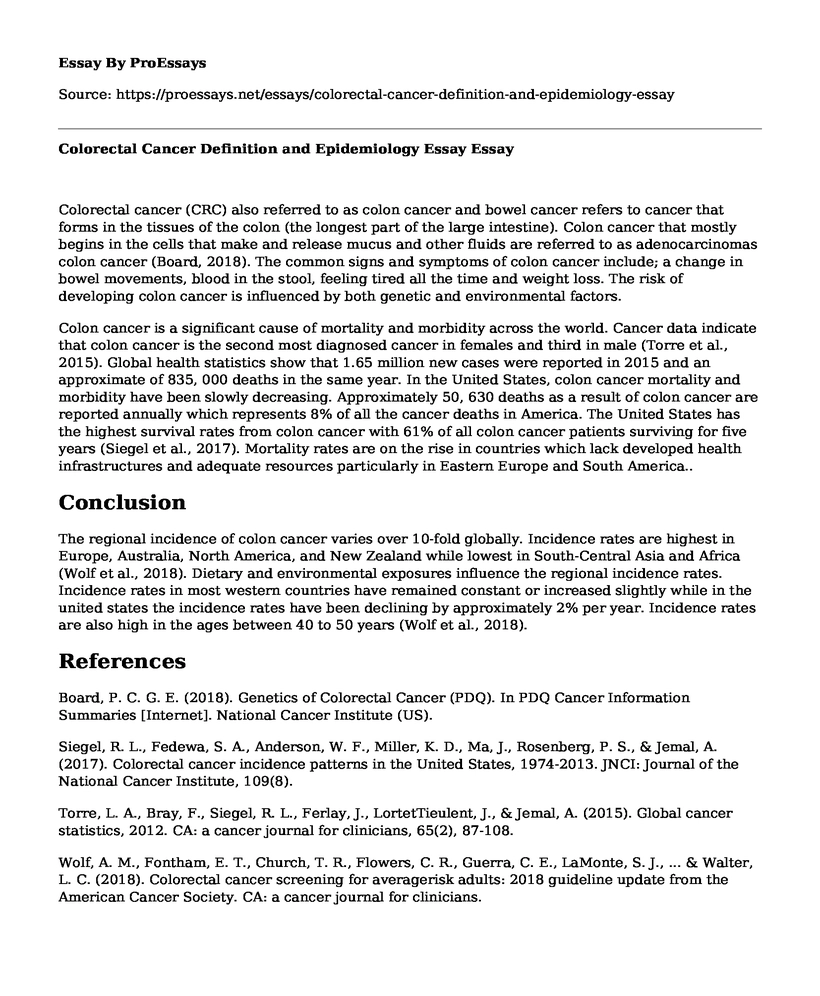Colorectal cancer (CRC) also referred to as colon cancer and bowel cancer refers to cancer that forms in the tissues of the colon (the longest part of the large intestine). Colon cancer that mostly begins in the cells that make and release mucus and other fluids are referred to as adenocarcinomas colon cancer (Board, 2018). The common signs and symptoms of colon cancer include; a change in bowel movements, blood in the stool, feeling tired all the time and weight loss. The risk of developing colon cancer is influenced by both genetic and environmental factors.
Colon cancer is a significant cause of mortality and morbidity across the world. Cancer data indicate that colon cancer is the second most diagnosed cancer in females and third in male (Torre et al., 2015). Global health statistics show that 1.65 million new cases were reported in 2015 and an approximate of 835, 000 deaths in the same year. In the United States, colon cancer mortality and morbidity have been slowly decreasing. Approximately 50, 630 deaths as a result of colon cancer are reported annually which represents 8% of all the cancer deaths in America. The United States has the highest survival rates from colon cancer with 61% of all colon cancer patients surviving for five years (Siegel et al., 2017). Mortality rates are on the rise in countries which lack developed health infrastructures and adequate resources particularly in Eastern Europe and South America..
Conclusion
The regional incidence of colon cancer varies over 10-fold globally. Incidence rates are highest in Europe, Australia, North America, and New Zealand while lowest in South-Central Asia and Africa (Wolf et al., 2018). Dietary and environmental exposures influence the regional incidence rates. Incidence rates in most western countries have remained constant or increased slightly while in the united states the incidence rates have been declining by approximately 2% per year. Incidence rates are also high in the ages between 40 to 50 years (Wolf et al., 2018).
References
Board, P. C. G. E. (2018). Genetics of Colorectal Cancer (PDQ). In PDQ Cancer Information Summaries [Internet]. National Cancer Institute (US).
Siegel, R. L., Fedewa, S. A., Anderson, W. F., Miller, K. D., Ma, J., Rosenberg, P. S., & Jemal, A. (2017). Colorectal cancer incidence patterns in the United States, 1974-2013. JNCI: Journal of the National Cancer Institute, 109(8).
Torre, L. A., Bray, F., Siegel, R. L., Ferlay, J., LortetTieulent, J., & Jemal, A. (2015). Global cancer statistics, 2012. CA: a cancer journal for clinicians, 65(2), 87-108.
Wolf, A. M., Fontham, E. T., Church, T. R., Flowers, C. R., Guerra, C. E., LaMonte, S. J., ... & Walter, L. C. (2018). Colorectal cancer screening for averagerisk adults: 2018 guideline update from the American Cancer Society. CA: a cancer journal for clinicians.
Cite this page
Colorectal Cancer Definition and Epidemiology Essay. (2022, Sep 04). Retrieved from https://proessays.net/essays/colorectal-cancer-definition-and-epidemiology-essay
If you are the original author of this essay and no longer wish to have it published on the ProEssays website, please click below to request its removal:
- Pressure Ulcer Paper Example
- The Role of End Users in Incident Reporting Essay Example
- The Role of NFIP in Emergency Management at the Federal Level
- Paper Example on Vitamin D Supplementation in Children With IBS and Other Chronic Diseases
- Essay Sample on Rural Bhutan: Quality Medical School & Hospital Benefits Local People
- Essay on Oxycontin: A Drug Used to Relieve Pain of Chronic Diseases
- Free Report on Culture Competence: Essential for Quality Nursing Practice







